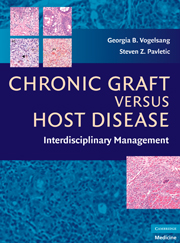Book contents
- Frontmatter
- Contents
- List of Contributors
- Preface
- PART I GENERAL PRINCIPLES
- PART II CLINICAL MANAGEMENT
- 9 Diagnosis and Staging
- 10 Chronic Graft versus Host Disease Pharmacology
- 11 Prevention of Chronic Graft versus Host Disease
- 12 Front Line Treatment of Chronic Graft versus Host Disease
- 13 Salvage Therapy in Chronic Graft versus Host Disease
- 14 Evaluating Therapeutic Response in Chronic Graft versus Host Disease
- 15 General Principles of Ancillary and Supportive Care
- PART III ORGAN SITE OR SYSTEM-SPECIFIC MANIFESTATIONS
- PART IV SPECIAL CONSIDERATIONS IN CHRONIC GVHD
- Index
- Plate section
12 - Front Line Treatment of Chronic Graft versus Host Disease
from PART II - CLINICAL MANAGEMENT
Published online by Cambridge University Press: 26 August 2009
- Frontmatter
- Contents
- List of Contributors
- Preface
- PART I GENERAL PRINCIPLES
- PART II CLINICAL MANAGEMENT
- 9 Diagnosis and Staging
- 10 Chronic Graft versus Host Disease Pharmacology
- 11 Prevention of Chronic Graft versus Host Disease
- 12 Front Line Treatment of Chronic Graft versus Host Disease
- 13 Salvage Therapy in Chronic Graft versus Host Disease
- 14 Evaluating Therapeutic Response in Chronic Graft versus Host Disease
- 15 General Principles of Ancillary and Supportive Care
- PART III ORGAN SITE OR SYSTEM-SPECIFIC MANIFESTATIONS
- PART IV SPECIAL CONSIDERATIONS IN CHRONIC GVHD
- Index
- Plate section
Summary
INTRODUCTION
This chapter outlines an approach for front line therapy of chronic graft versus host disease (GVHD). High-dose glucocorticoids have served as the mainstay of treatment since the early 1980s, and the adjunctive administration of a calcineurin inhibitor may reduce the amount or duration of glucocorticoid treatment needed to control the disease. Judicious use of glucocorticoids at the lowest effective dose and alternate-day administration can minimize steroid-related side effects. Antibiotic prophylaxis to prevent infection and supportive care to minimize morbidity and prevent disability are critically important components in the management of patients with chronic GVHD. Approximately 50% of patients with chronic GVHD are able to discontinue immunosuppressive treatment within 5 years after the diagnosis, and 10% require continued treatment beyond 5 years. The remaining 40% die or develop recurrent malignancy before chronic GVHD resolves. Improved understanding of the pathogenesis of the disease will be needed in order to develop more effective therapy. The primary challenge for the future will be the discovery of targeted approaches that control chronic GVHD, while preserving graft-versus-malignancy effects mediated by immunologic activity of donor cells against neoplastic cells in the recipient and allowing reconstitution of normal immune defenses against pathogens.
Studies during the early 1980s demonstrated the importance of early diagnosis and the efficacy of glucocorticoid treatment in reducing morbidity and mortality among patients with chronic GVHD.
- Type
- Chapter
- Information
- Chronic Graft Versus Host DiseaseInterdisciplinary Management, pp. 124 - 133Publisher: Cambridge University PressPrint publication year: 2009
- 6
- Cited by



